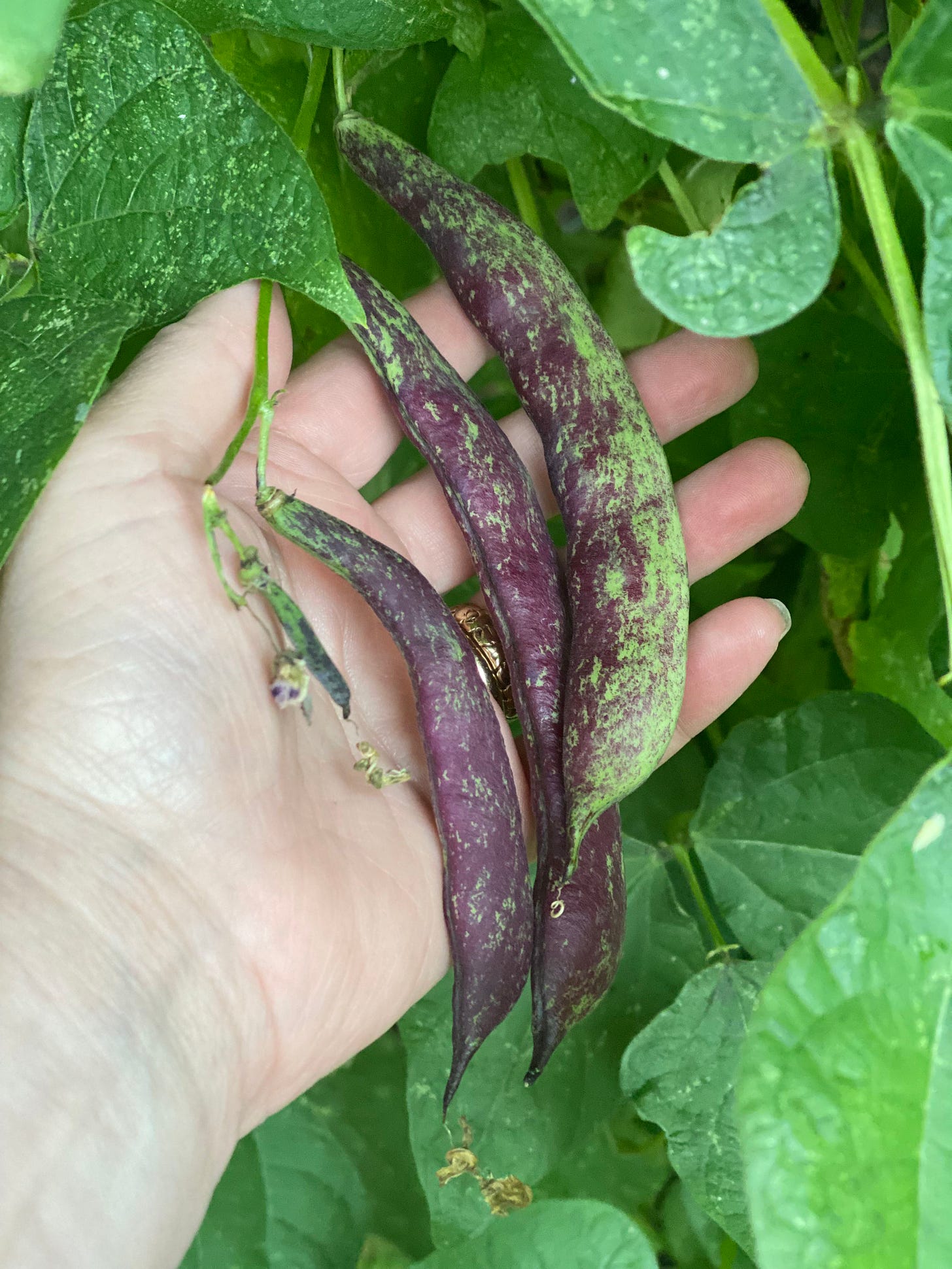Not an apocryphal story:
In the late 19th century, the great grandfather of one of my neighbors makes the decision to leave his home in Italy. He is, perhaps, still a teenager at the time, stepping onto a ship and into the unknown. His mother has (perhaps) packed his suitcase, unsure if she will ever see him again. There are clothes, there might be a small bible, there are probably some photographs so that her child doesn’t forget where he came from. And in his coat pocket she stashes a handful of beans: dried for long-term storage, mottled, black and white. He carries them to the United States, and when he eventually has the tiniest plot of earth to call his own, he plants them and harvests them, over and over again, year after year, decade after decade. He hands the offspring of the original beans to whomever he can: his wife’s family, his neighbors, his friends, his colleagues, his children, his grandchildren. And every year, each of these people plants the descendants of the traveling beans, harvests, dries, saves, and passes them along. The great-grandbeans of the original handful feed generations for over a century. They have been soaked and slow-cooked for hours with herbs and aromatics in warm wood ovens, Magic Chefs, AGAs, and Vikings. They have been simmered in hand-made micaceous clay pots on back burners. They have been folded into soups and stews, mashed into pastes, tossed with pastas, ground into flour.
This is not meant to be romantic or twee; this is about beans, and the power of the mundane in which lives the extraordinary—-a fact that, in a world of exceptionalism and forward-thinking and modernism and speed and disconnection from history, often doesn’t even occur to us.
These beans have fed my family since 2004, when a handful were given to me by my neighbor as a welcoming gift when we first moved to our neighborhood, long before they knew us, and long before we broke ground on a garden. Over the years, I have shared them with friends in upstate New York, Nashville, New Mexico, and sent them back over the Atlantic to Dorset. Each recipient has continued to plant, harvest, and store the beans, and every season, they share a few with others.
Jonas Salk is quoted by author and naturalist Rob Macfarlane as having been the first to ask Are we being good ancestors? Is it possible for us to care vitally for that which we will never be around to see? In a world of instant gratification, where we move through life making decisions that never take into account their impact on generations far beyond our own, we often hear why bother? It’s not my problem. It’s not my fight. It’s not my battle. Who cares; I’ll be long-dead.
And yet, when faced with the possibility of eating a bean that is the descendant of one carried in the coat pocket of an Italian teenager during the reign of Queen Victoria, we are thrilled. These are ghost beans, and eating them is like looking at a constellation billions of light years away: time slams shut. We are face to face with eons. We are growing, and eating history. What the Italian teenager did affects us now and does so directly: when our beans are harvested in our suburban vegetable garden in New England, a two hour train ride from Manhattan, we break the stalks and leaves down into the dirt, dig them in well and turn them. They will continue to feed and nourish the soil with organic matter for the next year and the year after that, whether I am here or I am not.
Gardening is a contract with hope.
Gardening, as I wrote in Motherland, is a contract with hope, and hope is at the core of the ancestor question. To care for and nurture something that we may never see is to actively acknowledge one’s responsibility to species and planet, and antithetical to modern egoism; this is why the destruction of 2,500 year old fruiting olive trees, whether by wildfire or vandalism designed to specifically starve people of their history, culture, and food, is reprehensible, and not unlike our looking up into the stars light years away, and suddenly seeing nothing.
A young Italian boy says goodbye to his home and his family, and crosses the Atlantic alone with a pocket full of beans. More than a century later, descendants of those beans are providing sustenance to a person the boy could never dream of meeting, who is writing about them on a computer which, with the touch of one key, will reach readers as far north as Tromso and as far south as Patagonia, in seconds. And yet, always yearning for order out of chaos and wanting assurance that what I have in my kitchen is something truly exceptional, when I sent a package of them to legendary Italian food writer Marcella Hazan — they were recently harvested and still in their green and purple pods — she wrote me a note, gently admonishing me for my ignorance.
They are just immature borlottis, she said, of the kind we would buy at the Rialto market in Venice, where they are a local specialty. The fresh beans themselves I might cook in olive oil with chopped onion, guanciale or pancetta, and sage. They are very pretty.
I will eat them this way forever; there is truly magic in the mundane, and beauty in the ancient.
A Method for Cooking Dried Beans
(Marcella Hazan, from The Classic Italian Cookbook, 1976)
When fresh beans are not available, most Italian cooks use dried beans rather than canned, precooked beans. Dried beans are not only much more economical than canned beans, but, when properly cooked, they have better texture than the generally mushy canned variety. You can buy packed dried beans in all supermarkets, but in any cities there are Greek and other stores that sell them loose, by weight. These are still a better buy than the prepacked beans, and usually offer a far broader selection.
Dried beans should always be soaked before cooking, otherwise their skins will burst before the beans become tender. There are many techniques for cooking dried beans. The following has given consistently successful results, especially with Great Northern beans or kidney beans, which are the closest to the white beans that usually go into Italian soups.
Put the desired quantity of beans in a bowl and cover them by 2 inches with cold water. Let them soak overnight in a warm place, such as over the pilot flame of a gas stove. (Do not use a plastic bowl!)
The following day, preheat the oven to 325 degrees F.
Rinse and drain the beans, put them in a flameproof casserole and cover them with cold water by 2 inches.
Bring the beans to a moderate boil on top of the stove, then cover the pot and place in the middle of the preheated oven. Cook until tender, about 40 to 60 minutes, depending on the beans. Keep them in their liquid until you are ready to use them.
Note: I have used this non-recipe recipe for years, but since receiving Marcella’s note about my immature borlottis, I generally add at step 3 half an onion cut into quarters, a few cloves of garlic, a sprig of rosemary, and a small chunk of pancetta. I have successfully omitted the pancetta and added the rind of a piece of Parmigiana Reggiano, and a small punch of salt. To serve, I strain out the beans and aromatics, and reserve the cooking liquid to use as the base for bean soup, or Minestrone, always drizzled before serving with excellent quality extra virgin olive oil.






Beautiful!!
I am very appreciative of this very informative and helpful response. Thank you very much.